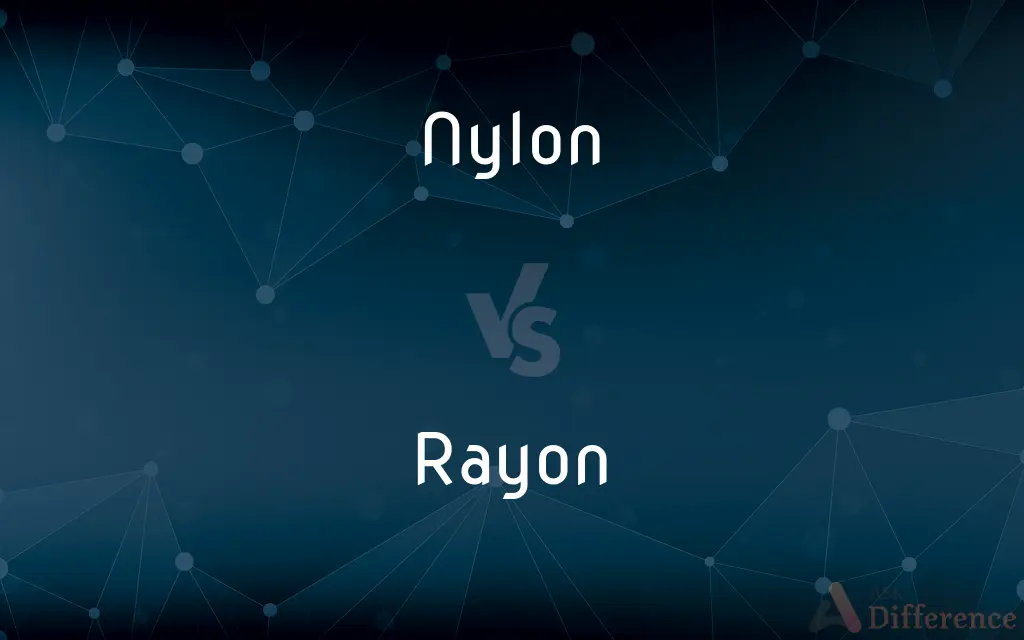Nylon vs. Rayon — What's the Difference?
By Tayyaba Rehman & Maham Liaqat — Updated on April 14, 2024
Nylon is a synthetic polymer known for its strength and durability, while rayon, a semi-synthetic fiber, is prized for its silk-like feel and breathability.

Difference Between Nylon and Rayon
Table of Contents
ADVERTISEMENT
Key Differences
Nylon is a synthetic fiber made from petroleum products, known for its high strength and excellent resilience. On the other hand, rayon is a semi-synthetic fiber made from regenerated cellulose derived from plant sources, emphasizing comfort and a soft texture.
Nylon exhibits superior resistance to wear and abrasion, making it ideal for heavy-duty applications like outdoor gear and carpets. Whereas rayon is more delicate, requiring careful handling, especially when wet, to maintain its integrity.
Nylon is inherently hydrophobic, meaning it repels water, making it quick to dry and suitable for swimwear and activewear. Rayon, conversely, is highly absorbent, which enhances its ability to dye well but makes it less suitable for moisture-heavy environments.
Nylon retains its shape and does not wrinkle easily, benefiting garments and items that require low maintenance. On the other hand, rayon can wrinkle easily and often requires gentle washing and ironing to preserve its appearance.
Nylon generates static electricity and can sometimes feel synthetic to the touch, which can be a drawback for comfort-focused clothing. In contrast, rayon offers a smoother, cooler feel that drapes beautifully, mimicking natural fibers like cotton and silk.
ADVERTISEMENT
Comparison Chart
Origin
Synthetic, petroleum-based
Semi-synthetic, cellulose-based
Durability
High durability and abrasion resistance
Less durable, prone to tearing when wet
Water Resistance
Hydrophobic, repels water
Hydrophilic, absorbs water
Maintenance
Low maintenance, wrinkle-resistant
High maintenance, wrinkles easily
Feel and Usability
Feels synthetic, static-prone
Soft, smooth, drapes well
Compare with Definitions
Nylon
A tough, lightweight synthetic polymer used primarily in fabrics and plastics.
The nylon jacket proved to be waterproof during the downpour.
Rayon
A fiber formed by regenerating natural materials into a usable textile.
Her rayon dress felt soft and light, perfect for the summer heat.
Nylon
A material noted for its high melting point and thermal resistance.
Nylon cooking utensils can withstand high temperatures without melting.
Rayon
Requires careful laundering to prevent damage and shrinkage.
The label cautioned to wash the rayon blouse in cold water only.
Nylon
Often used in the production of hosiery and sportswear due to its elasticity.
Her nylon stockings were remarkably durable.
Rayon
Often blended with other fibers to enhance durability and texture.
The blend of cotton and rayon in the fabric improved its breathability.
Nylon
Can be engineered into fibers, sheets, or molded parts for various uses.
The gears in the machine are made of specially formulated nylon.
Rayon
Prone to wrinkling but favored for its smooth drape and natural feel.
Despite its tendency to wrinkle, the rayon shirt draped elegantly.
Nylon
Known for its resistance to oils and chemicals.
Nylon gloves are used in the lab to protect against chemical splashes.
Rayon
Popular in fashion for its ability to emulate silk.
The rayon scarf had a luxurious sheen that resembled silk.
Nylon
Nylon is a generic designation for a family of synthetic polymers composed of polyamides (repeating units linked by amide links). Nylon is a silk-like thermoplastic, generally made from petroleum, that can be melt-processed into fibers, films, or shapes.
Rayon
Rayon is a synthetic fiber, made from natural sources of regenerated cellulose, such as wood and related agricultural products. It has the same molecular structure as cellulose.
Nylon
Any of a family of high-strength, resilient synthetic polymers, the molecules of which contain the recurring amide group CONH.
Rayon
Any of several synthetic textile fibers produced by forcing a cellulose solution through fine spinnerets and solidifying the resulting filaments.
Nylon
Cloth or yarn made from one of these synthetic materials.
Rayon
A fabric so woven or knit.
Nylon
Nylons Stockings made of one of these synthetic materials.
Rayon
A manufactured regenerated cellulosic fiber.
Nylon
Originally, the DuPont company trade name for polyamide, a copolymer whose molecules consist of alternating diamine and dicarboxylic acid monomers bonded together; now generically used for this type of polymer.
Rayon
Ray; beam.
Nylon
(in the plural) A stocking originally fabricated from nylon; also used generically for any long, sheer stocking worn on a woman's legs.
I tore a hole in my nylons while walking home through the woods.
Rayon
A synthetic fiber, made of thin filaments of regenerated cellulose, extruded from a solution of viscose. Called also viscose fiber and viscose rayon fiber.
Nylon
(perjoratively, by comparison to silk) A Queen's Counsel, King's Counsel or Senior Counsel who was appointed as a courtesy, rather than on merit.
Rayon
A textile fabric made from rayon{1}.
Nylon
Any of several thermoplastic polyamide plastics, comprising a family of high-strength resilient synthetic materials, used mostly in fibers.
Rayon
A synthetic silklike fabric
Nylon
A synthetic fabric consisting of fibers of nylon[wn1].
Nylon
Stockings made of a thin form of nylon{2}, especially full-length stockings either sheer of of varying shades.
Nylon
A thermoplastic polyamide; a family of high-strength resilient synthetic materials
Nylon
A synthetic fabric
Common Curiosities
Can rayon be used for outdoor apparel?
Rayon is less suitable for outdoor apparel as it absorbs moisture and is less durable under rough conditions.
Is nylon more durable than rayon?
Yes, nylon is generally more durable and resistant to abrasion compared to rayon.
Is rayon environmentally friendly?
While rayon is made from natural materials, the chemical process used to produce it can be environmentally taxing.
Which fabric is more absorbent, nylon or rayon?
Rayon is more absorbent than nylon, which is hydrophobic and repels water.
Does nylon require special care when washing?
Nylon is quite resilient and does not require special care; it is machine washable and dries quickly.
Is nylon environmentally friendly?
Being a synthetic fiber, nylon is not considered very environmentally friendly due to its petroleum-based origin and long degradation time.
What is nylon made from?
Nylon is a synthetic fiber made from petroleum-based products.
What is rayon made from?
Rayon is a semi-synthetic fiber made from cellulose, which is derived from plants.
Which fiber is better for sportswear, nylon or rayon?
Nylon is better suited for sportswear due to its durability, quick-drying properties, and resistance to moisture.
How should rayon garments be cared for?
Rayon garments should be washed gently and air-dried to avoid shrinking and maintain their shape.
Can nylon be dyed easily?
Nylon can be dyed but requires specific types of dyes due to its synthetic nature.
Why does rayon wrinkle easily?
Rayon fibers are weaker, especially when wet, making the fabric prone to wrinkling.
Are there different types of rayon?
Yes, there are several types of rayon, including viscose, modal, and lyocell, each with slightly different properties.
Is nylon used in automotive applications?
Yes, nylon is widely used in the automotive industry for parts like fans, gears, and other components due to its strength and heat resistance.
Which fabric is better for a hot climate, nylon or rayon?
Rayon is better for hot climates as it is more breathable and cooler against the skin.
Share Your Discovery

Previous Comparison
Ultrabook vs. Laptop
Next Comparison
Esterification vs. SaponificationAuthor Spotlight
Written by
Tayyaba RehmanTayyaba Rehman is a distinguished writer, currently serving as a primary contributor to askdifference.com. As a researcher in semantics and etymology, Tayyaba's passion for the complexity of languages and their distinctions has found a perfect home on the platform. Tayyaba delves into the intricacies of language, distinguishing between commonly confused words and phrases, thereby providing clarity for readers worldwide.
Co-written by
Maham Liaqat













































